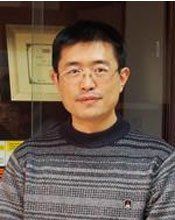
基本情況
王任小,男,1972年04月生,1994年09月師從北京大學唐有祺教授,於1999年07月獲得博士學位。“百人計畫”研究員,課題組長。
研究方向
計算化學生物學
以分子模擬、生物信息學和化學信息學為手段,研究重要生物大分子的功能和機制,研究有機小分子和生物大分子相互作用的基本理論,發展和完善計算機輔助藥物設計方法。
以與重大疾病過程相關的生物大分子作為靶標,運用計算機輔助藥物設計方法並結合必要的化學和生物實驗手段,尋找和設計可以有效調節這些靶標分子功能的有機小分子化合物。
承擔的主要科研項目
目前承擔或參與國家自然科學基金委、科技部、中國科學院以及上海市科委在研項目多項。
工作經歷
2005年8月至今:中國科學院上海有機化學研究所,“百人計畫”研究員
2001年9月至2005年7月:美國密西根大學(University of Michigan)醫學院,research investigator
2000年9月至2001年8月:美國喬治敦大學(Georgetown University)癌症中心,postdoctoral fellow
1999年9月至2000年8月:美國加州大學洛杉磯分校(University of California Los Angeles)化學系, postdoctoral fellow
教育背景
1994年9月至1999年7月:北京大學物理化學研究所,理學博士, 導師:唐有祺院士
1989年9月至1994年7月:北京大學化學系,理學學士,導師:來魯華教授
主要獲獎情況
2001年,美國Cap CURE癌症基金會Young Investigator Award
2001年,中國教育部“全國優秀博士學位論文”
主要論文
2000年以來發表的論文清單
1. Cheng, T.; Zhao, Y.; Li, X.; Lin, F.; Xu, Y.; Zhang, X.; Li, Y.; Wang, R.*; Lai, L. “Computation of Octanol-Water Partition Coefficients by Guiding an Additive Model with Knowledge”, J. Chem. Inf. Model. 2007, 47, ASAP.
2. Zhao, Y.; Cheng, T.; Wang, R.* “Automatic Perception of Organic Molecules Based on Essential Structural Information”, J. Chem. Inf. Model. 2007, 47, 1379-1385.
3. Wang, R.*; Lin, F.; Xu, Y.; Cheng, T. “I-SOLV: A new surface-based empirical model for computing solvation free energies”, J. Mol. Graph. Model. 2007, 26, 368-377.
4. Feng, D.-J.; Wang, G..-T.; Wu, J.; Wang, R.-X.; Li, Z.-T. “Hydrogen bonding-driven elastic bis(zinc)porphyrin receptors for neutral and cationic electron-deficient guests with a sandwich-styled complexing pattern”, Tetrahedron Lett. 2007, 48, 6181-6185.
5. Li, C.; Wang, G.; Yi, H.; Jiang, X.; Li, Z.*; Wang, R.* “Diastereomeric Recognition of Chiral Foldamer Receptors for Chiral Glucoses”, Org. Lett. 2007, 9, 1797-1800.
6. Ma, D.; Yu, S.; Li, B.; Chen, L.; Chen, R.; Yu, K.; Zhang, L.; Chen, Z.; Zhong, D.; Gong, Z.; Wang, R.; Jiang, H.; Pei, G. “Synthesis and Biological Evaluation of 1,3,3,4-Tetrasubstituted Pyrrolidine CCR5 Receptor Antagonists. Discovery of a Potent and Orally Bioavailable Anti-HIV Agent”, ChemMedChem, 2007, 2, 187-193.
7. Tang, G.; Ding, K.; Nikolovska-Coleska, Z.; Yang, C.-Y.; Qiu, S.; Shangary, S.; Wang, R.; Guo, J.; Gao, W.; Meagher, J.; Stuckey, J.; Krajewski, K.; Jiang, S.; Roller, P. P.; Wang, S. “Structure-Based Design of Flavonoid Compounds As a New Class of Small-Molecule Inhibitors of the Anti-apoptotic Bcl-2 Proteins”, J. Med. Chem. 2007, 50, 3163-3166.
8. Tang, G.-Z.; Yang, C.-Y.; Nikolovska-Coleska, Z.; Guo, J.; Qiu, S.; Wang, R.-X.; Gao, W.; Wang, G.-P.; Stuckey, J.; Krajewski, K.; Jiang, S.; Roller, P. P.; Wang, S.-M. “Pyrogallol-based molecules as potent inhibitors of the antiapoptotic Bcl-2 proteins”, J. Med. Chem. 2007, 50, 1723-1726.
9. Lu, Y.; Wang, R.; Yang, C.-Y.; Wang, S. “Analysis of ligand-bound water molecules in high-resolution crystal structures of protein-ligand complexes”. J. Chem. Inf. Model. 2007, 47, 668-675.
10. Xu, Y.; Wang, R.* “A Computational Analysis of the Binding Affinities of FKBP12 Inhibitors Using the MM-PB/SA Method”, Proteins, 2006, 64, 1058-1068.
11. Yu, S.; Pu, X.; Cheng, T.; Wang, R.; Ma, D. “Total Synthesis of Clavepictines A and B and Pictamine”, Org. Lett. 2006, 8, 3179-3182.
12. Ma, D.; Jiang, Y.; Chen, F.; Gong, L.-k.; Ding, K.; Xu, Y.; Wang, R.; Ge, A.; Ren, J.; Li, J.; Li, J.; Ye, Q. “Selective Inhibition of Matrix metalloproteinase Isozymes and in Vivo Protection against emphysema by Substituted -Keto Carboxylic Acids”, J. Med. Chem. 2006, 49, 456-458.
13. Wang, G.; Nikolovska-Coleska, Z.; Yang, C.-Y.; Wang, R.; Tang, G.; Guo, J.; Shangary, S.; Qiu, S.; Gao, W.; Yang, D.; Meagher, J.; Stuckey, J.; Krajewski, K.; Jiang, S.; Roller, P. P.; Abaan, H. O.; Tomita, Y.; Wang, S. “Structure-Based Design of Potent Small-Molecule Inhibitors of Anti-Apoptotic Bcl-2 Proteins”, J. Med. Chem., 2006, 49, 6139-6142.
14. Yang, C.-Y.; Wang, R.; Wang, S. “M-Score: A Knowledge-Based Potential Scoring Function Accounting for Protein Atom Mobility”, J. Med. Chem. 2006, 49, 5903-5911.
15. Wang, R.; Fang, X.; Lu, Y.; Yang, C.-Y.; Wang, S. “The PDBbind Database: Methodologies and Updates”, J. Med. Chem. 2005, 48, 4111-4119.
16. Yang, C.-Y.; Wang, R.; Wang, S. “A Systematic Analysis of the Effect of Small-Molecule Binding on Protein Flexibility of the Ligand-Binding Sites”, J. Med. Chem. 2005, 48, 5648-5650.
17. Song, H.; Wang, R.; Wang, S; Lin, J. “A low-molecular-weight compound discovered through virtual database screening inhibits Stat3 function in breast cancer cells”, Proc. Natl. Acad. Sci. 2005, 102, 4700-4705.
18. Wang R.; Lu Y.; Fang X.; Wang S. “An Extensive Test of 14 Scoring Functions Using the PDBbind Refined Set of 800 Protein-Ligand Complexes”, J. Chem. Inf. Comput. Sci. 2004, 44, 2114-2125.
19. Real P.J.; Cao, Y.; Wang R.; Nikolovska-Coleska Z.; Sanz-Ortiz J.; Wang S.; Fernandez-Luna J. L. “Breast cancer cells can evade apoptosis-mediated selective killing by a novel small molecule inhibitor of Bcl-2”, Cancer Research, 2004, 64, 7947-7953.
20. Wang, R.; Fang, X.; Lu, Y.; Wang, S. “The PDBbind Database: Collection of Binding Affinities for Protein-Ligand Complexes with Known Three-Dimensional Structures”, J. Med. Chem. 2004, 47, 2977-2980.

